How to build a website like GetYourGuide
GetYourGuide is an online marketplace that offers a wide range of tours, activities, and experiences for travelers. Build your marketplace similar to GetYourGuide and start connecting people with unique travel experiences.
GetYourGuide has become a leader in the travel experience marketplace, connecting travelers with unique activities worldwide. Operating across over 190 countries, it offers a vast range of curated local experiences for global audiences.
While GetYourGuide has scaled significantly, the marketplace model also allows room for smaller, specialized players to succeed. In this article, we'll guide you through building your own marketplace platform, covering essential features and step-by-step instructions—from idea validation to launching a Minimum Viable Platform.
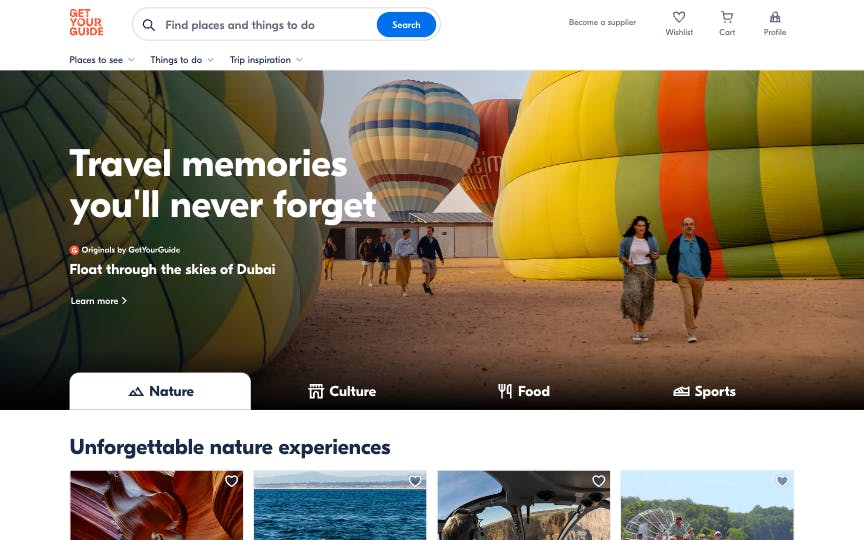
Key takeaways from this article:
- Why build a site like GetYourGuide? Online travel marketplaces are expanding, entry barriers are low, and there's room to refine your idea as you go.
- How does GetYourGuide work? It connects travelers with local experiences worldwide, generating revenue primarily from commission fees.
- Why did GetYourGuide succeed? It identified a gap in the travel market and solved it effectively.
- Who are GetYourGuide’s competitors? Similar marketplaces include Viator, Klook, and Musement.
- Steps to create a GetYourGuide-like platform: Follow 10 steps from idea generation to platform building and scaling.
The marketplace model grows year after year. In 2021, 67% of all global e-commerce came from marketplaces, with the top 100 generating over $3.2 trillion. By 2027, third-party sales in marketplaces will be the largest retail channel globally.
Opportunities exist for smaller, specialized players to succeed by offering curated experiences that the larger platforms, like GetYourGuide, may not focus on.
Launching your own marketplace is also simpler and more affordable than ever:
- No inventory required: Your role is facilitating transactions, not holding inventory, which keeps overhead low.
- Low barrier to entry: No-code marketplace builders like Sharetribe let you launch an MVP in just one day, even without technical skills.
- Quick iteration: With fast deployment, you can easily test ideas, validate them with real transactions, and refine your platform—avoiding high upfront costs.
- Scalability: As your marketplace grows, you can add custom features and integrations to expand the core no-code platform.
In short, with a large market potential, an asset-light approach, and accessible tools like Sharetribe, ambitious entrepreneurs have a real opportunity to create the next breakout marketplace for travel experiences, just as GetYourGuide did.
For buyers, a marketplace like GetYourGuide offers a seamless experience to explore and book various travel activities.
Users can browse multiple options, read detailed descriptions, and view authentic reviews from fellow travelers. With a simple booking process and secure payment options, buyers can easily plan and reserve their desired experiences, ensuring a hassle-free and enjoyable trip.
For sellers, a marketplace like GetYourGuide offers a platform to showcase their unique experiences and services to a global audience. They can create listings, set their prices, and manage availability.
The marketplace handles marketing, customer support, and secure payments, allowing sellers to focus on delivering exceptional experiences and expanding their customer base.
The business model of GetYourGuide is mainly a commission-based system, which is the most common monetization strategy among successful marketplaces. This means the platform takes a 20-30% commission fee off the total value of each transaction. This percentage is taken from suppliers on every booking made through the marketplace.
GetYourGuide generates revenue through various other channels too. It also offers various marketing services to its suppliers, like featured listings and ads, to generate additional revenue.
Furthermore, the platform may also earn revenue from partnerships and mutual collaborations with other travel-related companies, where they receive a share of the earnings from referrals or cross-promotions.
In essence, GetYourGuide generates revenue by ensuring a smooth and easy customer booking experience and providing value-added services to its suppliers in exchange for a commission and other fees.
The most important functionality of a marketplace like GetYourGuide is to connect travelers with a wide range of activities, tours, and experiences in various destinations. This includes:
- Comprehensive listings: The marketplace should have a vast and diverse selection of activities and tours available for travelers to choose from. This can include sightseeing tours, adventure activities, cultural experiences, and more.
- User reviews and ratings: The marketplace should provide user-generated reviews and ratings for each activity, allowing travelers to make informed decisions based on the experiences of others.
- Booking and payment system: A marketplace should have a secure and user-friendly booking and payment system that allows travelers to easily reserve and pay for their chosen activities. (Here's our complete guide to marketplace payments).
- Availability and real-time updates: It is crucial for the marketplace to display accurate availability and real-time updates for each activity, ensuring that travelers can book activities that are currently available.
- Customer support: A marketplace should offer reliable customer support to assist travelers with any queries, issues, or changes to their bookings.
- Mobile-friendly interface: With the increasing use of mobile devices, a marketplace should have a mobile-friendly interface or a dedicated mobile app to provide a seamless booking experience for travelers on the go.
- Local expertise: The marketplace should collaborate with local tour operators and guides to offer authentic and high-quality experiences, ensuring that travelers have access to knowledgeable and experienced professionals.
- Customization and personalization: The marketplace should allow travelers to customize their itineraries and preferences, providing options for tailored experiences based on their interests, group size, and other specific requirements.
- Transparent pricing: The marketplace should display clear and transparent pricing for each activity, including any additional fees or charges, to avoid any surprises for travelers during the booking process.
- Trust and safety: A marketplace should prioritize the safety and security of travelers by partnering with reputable and licensed tour operators, ensuring that all activities comply with safety standards and regulations.
Overall, the essential functionality of a marketplace like GetYourGuide is to provide a user-friendly platform that connects travelers with a wide range of activities while ensuring transparency, reliability, and a seamless booking experience.
Here are some platforms that can be considered a successful competitor to GetYourGuide:
1 . Viator
Viator is a significant competitor to GetYourGuide, offering a similar online marketplace for booking tours and activities. While both platforms have a wide range of options and global coverage, Viator has a more extensive inventory of tours and activities available in popular tourist destinations. However, GetYourGuide stands out with its user-friendly interface and innovative features like instant booking and mobile ticketing.
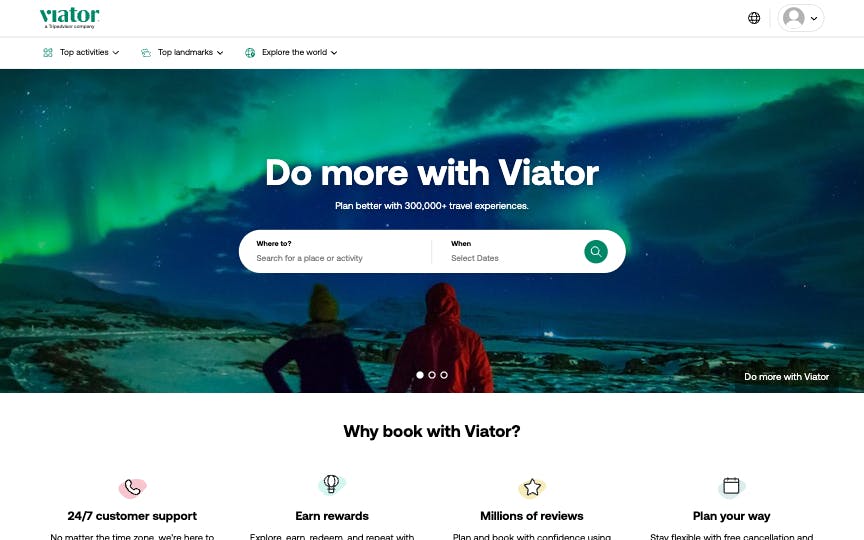
2 . TripAdvisor Experiences
As a leading travel platform, TripAdvisor Experiences competes with GetYourGuide by offering many tours and activities worldwide. While both platforms provide user reviews and ratings, GetYourGuide focuses more on curated experiences and personalized recommendations, making it easier for travelers to find unique and off-the-beaten-path activities. TripAdvisor Experiences, on the other hand, benefits from its extensive user base and integration with other TripAdvisor services.
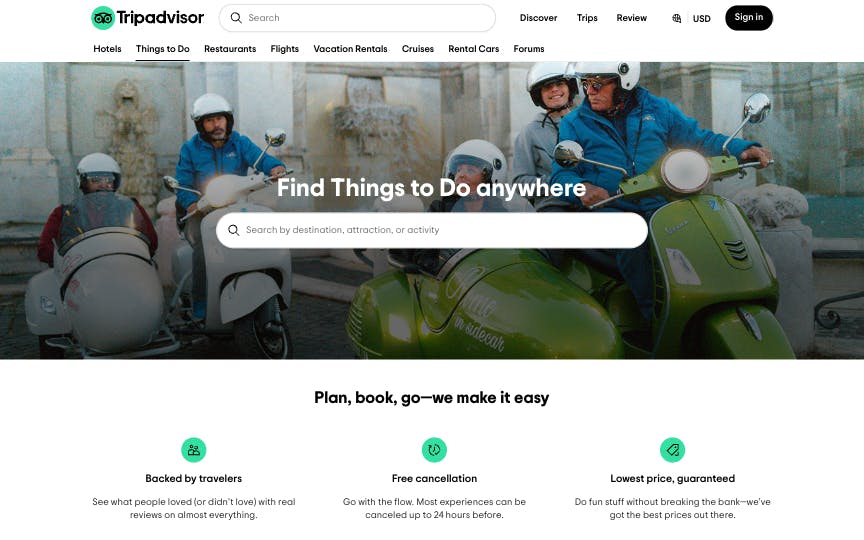
3 . Klook
Klook is another strong competitor to GetYourGuide, particularly in the Asian market. While both platforms offer a wide range of activities and experiences, Klook differentiates itself by providing exclusive deals and discounts, making it an attractive option for budget-conscious travelers. GetYourGuide, however, excels in customer service and responsiveness, ensuring a seamless booking experience and reliable support throughout the journey.
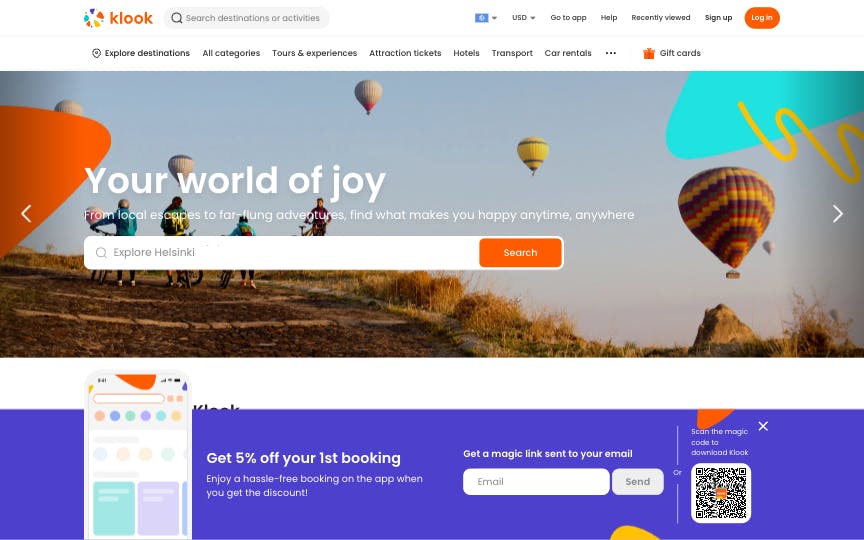
4 . Airbnb Experiences
Airbnb Experiences is a formidable competitor to GetYourGuide, leveraging its vast network of hosts to offer unique and immersive activities. While both platforms focus on providing authentic local experiences, Airbnb Experiences stands out by offering activities hosted by locals in their own homes or neighborhoods. GetYourGuide, on the other hand, provides a more diverse range of activities and has a more substantial presence in popular tourist destinations.
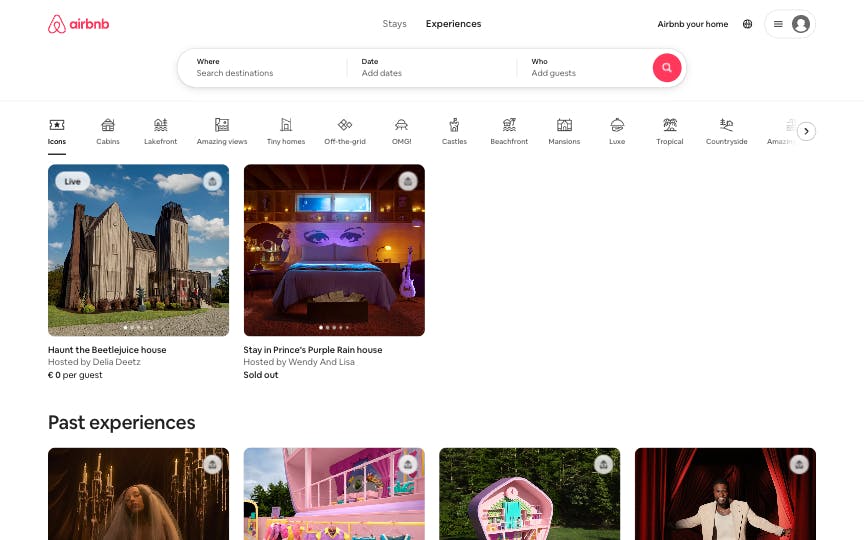
5 . Musement
Musement and GetYourGuide both connect travelers with unique experiences worldwide, yet each has a distinct approach. Musement emphasizes a curated selection of cultural and local activities, such as museum tickets, art tours, and food experiences, often appealing to travelers looking for cultural immersion. In contrast, GetYourGuide offers a broader range of travel activities, from adventure tours to local excursions, often focused on providing comprehensive options for popular destinations. While both platforms serve travelers seeking convenience and variety, Musement leans toward culturally enriching experiences, whereas GetYourGuide covers a wider spectrum of travel activities.
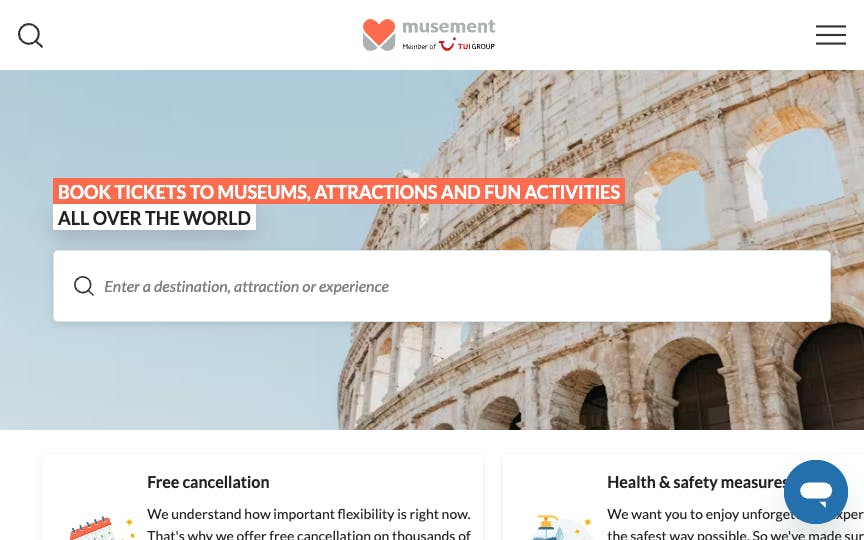
Founded by classmates Johannes Reck and Tao Tao in 2009, GetYourGuide has advanced significantly to become a popular internet booking platform.
Initially built to help tourists effectively navigate a foreign city by connecting them with amateur guides, the Berlin-based company has expanded to allow travelers to book professional tours and activities.
With a defined goal on the part of the founders to cause a revolutionary change in the world of travel, the company currently offers more than 60,000 products worldwide in 150 countries, 22 languages, and 40 currencies. It makes sense that the company is presently valued at nearly $2 billion.
Online marketplaces are great for sellers as they offer a venue to reach a broader audience, boost sales, and help reduce marketing costs. Buyers gain from shopping at their convenience, from any location, accessing a vast array of products, and enjoying competitive prices. Marketplace owners profit from transaction charges, increased traffic, and a varied product selection---this creates a win-win situation for all the parties involved.
The success of the online marketplace GetYourGuide can be attributed to several key factors. Firstly, the platform offers a wide range of activities and experiences, catering to the diverse interests and preferences of travelers. This extensive selection ensures something for everyone, attracting a large customer base.
Additionally, GetYourGuide provides a user-friendly interface and a seamless booking process, making it convenient and enjoyable for users to browse and book activities. The platform also prioritizes customer satisfaction by offering reliable customer support and listing only safe and high-quality experiences.
These factors, combined, have contributed to the success of GetYourGuide, making it a top choice for booking travel experiences online.
Over the years at Sharetribe, we’ve worked with hundreds of marketplace founders and here are ten steps that we found to form pretty good guidelines for building a tour guide marketplace like GetYourGuide:
- Identify a strong marketplace idea.
- Choose the right marketplace business model.
- Start with a focused scope.
- Pre-validate your marketplace idea.
- Build a marketplace platform, starting with an MVP (Minimum Viable Platform).
- Onboard your first sellers.
- Launch your marketplace.
- Reach problem-solution fit.
- Reach product-market fit.
- Scale into new markets.
Next, we’ll discuss the ten steps and how they can help you build a successful marketplace like GetYourGuide. However, If you want more information and useful resources, check out our complete guide on how to start an online marketplace.
While GetYourGuide holds a strong position in the tour experience marketplace, like with any incumbent, dominance also opens doors for new players to succeed by addressing unmet needs.
Niche opportunities could exist in specific regions, unique travel styles, or targeted customer segments that the larger platform may overlook.
By focusing on tailored experiences or specialized services, you can build a new marketplace that can differentiate itself, offering value where GetYourGuide may not.
Here's more about identifying a strong marketplace idea.
At Sharetribe, we found that the world’s top marketplaces earn revenue through one of six primary business models:
- Commission
- Subscription
- Listing fees
- Lead fees
- Freemium models
- Featured listings
GetYourGuide primarily follows a commission model, charging providers a percentage on each booking.
If you’re considering this approach, keep three things in mind: decide which side to charge, set your commission rate, and establish ways to prevent off-platform transactions.
GetYourGuide also diversifies revenue with promotional services, logistics fees, and direct offerings.
However, we typically advise new marketplaces to keep revenue models simple at launch. Over time, you can introduce additional streams as your platform matures, creating a more robust revenue foundation. Here's the complete guide to the marketplace business model.
Targeting a broad market can be tempting, but investors now prioritize real traction and fast liquidity. Transactions on your platform matter more than ambitious market size projections. A narrowly defined scope—such as a specific niche or region—helps you quickly build critical mass and achieve marketplace liquidity.
Initially, GetYourGuide took this approach by concentrating on tours and activities rather than general travel services. The narrower your scope, the lower your liquidity threshold, which means less cash burn and faster growth. Once your core segment stabilizes, expansion becomes easier.
Before diving into development, validate your marketplace idea. This means verifying that your assumptions about your marketplace idea align with real demand.
One effective approach is to engage potential activity providers and their customers, especially those currently listed on GetYourGuide. Ask them about their needs and whether they feel there’s room for a specialized platform like yours.
Indirect validation methods, such as analyzing online discussions, search volumes, competitor performance, and market reports, can further confirm your idea. For GetYourGuide, understanding traveler frustrations around fragmented activity booking options confirmed the demand for a more streamlined solution, enabling travelers and providers to connect effectively.
A marketplace MVP offers the core features required for early users to book and offer experiences. This lean version allows you to gather insights from real user interactions before investing heavily in development.
Even GetYourGuide's early versions kept functionality straightforward, focusing on reliable listings, simple booking processes, and clear provider information.
Today, even non-developers have multiple MVP options: hiring freelancers, finding a technical co-founder, or using no-code tools like Sharetribe.
No-code platforms enable rapid MVP launch, complete with essential features like checkout, seller onboarding, and order management—allowing for real transactions and feedback from day one.
Building initial marketplace supply is a common early-stage challenge. You'll need to be able to convince sellers that your marketplace has the potential to eventually bring them new business.
Bringing in the supply before opening to new customers is recommended because idle customers are more dangerous than idle sellers. The supply side usually has the patience to wait for customers to show. Customers aren't as flexible: if they don't find anything interesting on your marketplace, they'll very likely leave and never return.
To get your first sellers on board, focus on those who are likely to benefit most from the marketplace and might have a strong local following or specialized offerings. This helps build early credibility and attracts buyers.
Consider these tactics:
- Target local sellers with a strong fit for your niche.
- Engage with sellers at travel and tourism events.
- Personalize outreach and clearly communicate the value of your platform.
- Incentivize early joiners with perks like premium positioning or discounted fees.
Starting with a robust supply builds confidence, allowing buyers to see the marketplace’s value, and jumpstarting the network effect.
When your initial supply is onboard, it's time to launch your marketplace to the demand. Launching doesn’t need to be grand. Begin by attracting buyers to transact with sellers you’ve already onboarded.
Early users validate your platform and give you feedback for refinement. If some of your sellers also list on GetYourGuide, leverage their existing customer bases and promotional channels to drive traffic. You might also offer co-marketing support to help sellers share their offerings on your platform with their own audiences.
Experiment with low-cost marketing tactics:
- Encourage sellers to cross-promote their listings on your platform.
- Run targeted promotions in relevant communities and online forums.
- Consider press outreach and referral incentives.
The aim is simple: get real transactions to bring your marketplace to life.
Problem-solution fit means confirming that your marketplace addresses a real need. In this phase, transactions should happen regularly, with buyers and sellers finding clear value in the marketplace’s services. If interactions are happening but not translating into bookings, speak directly with users for feedback.
Consider questions like:
- Does the platform clearly communicate its purpose?
- Is the listing network wide enough to meet buyer expectations?
- Are there barriers in the booking or payment flow?
While GetYourGuide could focus solely on volume, resist the urge to scale too quickly; instead, refine your core offering first.
Product-market fit indicates that your marketplace serves a repeatable need within a sustainable model. Metrics like liquidity, repeat bookings, and user retention help indicate this fit. To enhance liquidity, focus on marketplace SEO, network effects, and targeted marketing.
When ready, venture funding may support growth, but be cautious. GetYourGuide’s success highlights the importance of balanced growth and strategic funding—investors will want to see a clear roadmap to profitability, not just rapid expansion. If you're considering raising funding, our complete guide to marketplace funding helps you evaluate your options and make the right call for your business, goals, and risk tolerance.
If external funding isn’t viable, platforms like Sharetribe allow for leaner scaling, making it possible to bootstrap and validate your model without needing immediate VC backing.
Once product-market fit is achieved, scale your marketplace with a phased approach. Begin with a proven playbook and enter new markets gradually, adjusting based on each market’s unique dynamics.
GetYourGuide grew organically by focusing on specific tourist activities. Similarly, avoid rushing into acquisitions or diverse services too soon. Expansion should follow clear results and a scalable model, supporting growth without diverting focus.
Launching a marketplace like GetYourGuide is now possible without coding, thanks to no-code tools like Sharetribe. With a clear plan, you can bring your travel marketplace idea to life quickly.
Here’s what it takes:
- Find a niche: Start with an underserved activity type or location.
- Pre-validate demand: Confirm interest from both providers and travelers.
- Launch with a Minimum Viable Platform (MVP): Use no-code for rapid setup.
- Onboard quality providers before marketing.
- Iterate with user feedback to reach problem-solution fit.
- Develop a playbook for product-market fit and growth.
Get started, be resourceful, and learn from real user behavior to refine your offering—just as GetYourGuide did.
Start your 14-day free trial
Create a marketplace today!
- Launch quickly, without coding
- Extend infinitely
- Scale to any size
No credit card required
